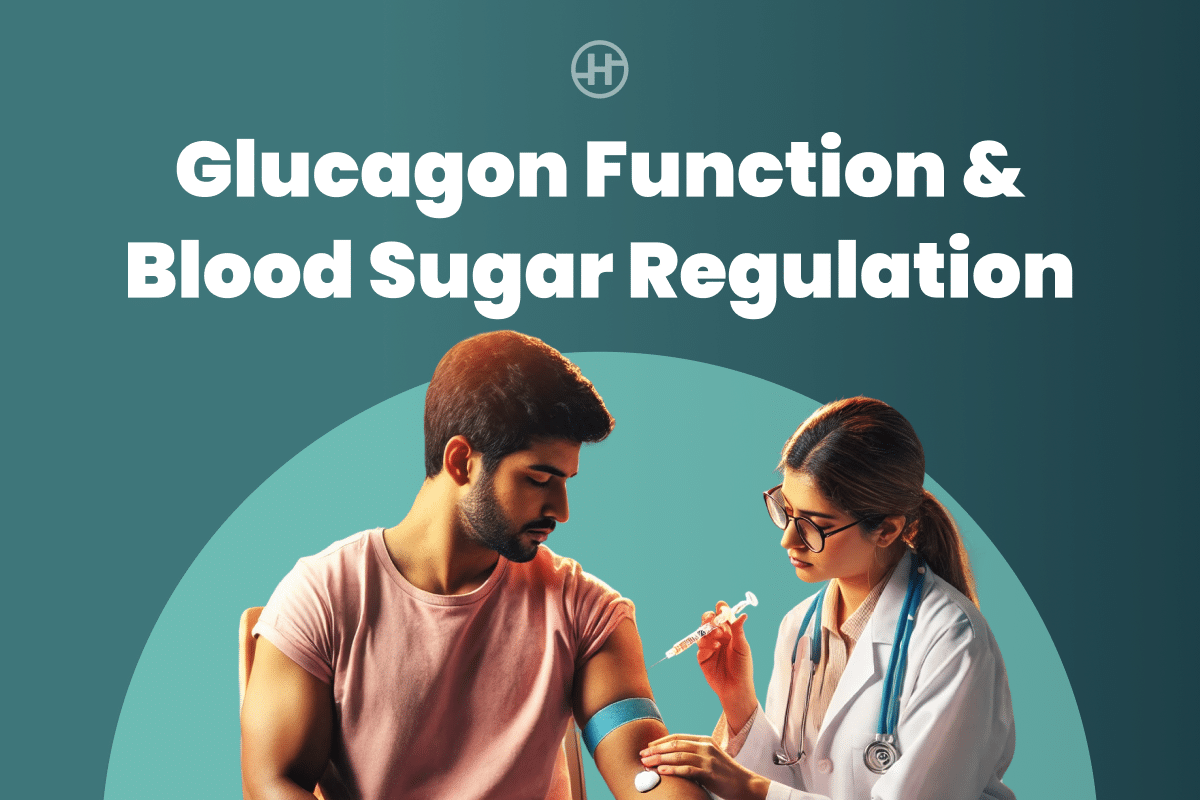Understanding Glucagon Function In Blood Sugar Regulation

Over the last few years, much attention has been given to insulin and its role in blood sugar management. But equally important (and often overlooked) is glucagon, a hormone that works in tandem with insulin to regulate the body’s glucose balance. Today, the scientific community and public health experts are paying renewed attention to glucagon, not just because of its counter-regulatory role, but also due to its implications in type 2 diabetes, metabolism, and fat oxidation.
If you are wondering, “Glucagon is secreted by which organ?” or want to understand the full scope of glucagon function, this article has you covered. We will explore how it works, how it differs from insulin, and why understanding both is vital for managing diabetes and overall health. With detailed sections on everything from blood glucose regulation to glucagon action in fat metabolism, this article is your comprehensive guide to one of the body’s most essential hormones.
Let us begin by addressing the basics before uncovering how this hormone impacts your body, your health, and your energy.
What is Glucagon?
Glucagon is a peptide hormone made up of 29 amino acids. It is secreted by the alpha cells found in the islets of Langerhans in the pancreas. The same pancreatic islets also contain beta cells, which secrete insulin. These two hormones, though opposite in function, work together to maintain blood glucose levels within a healthy range.
The glucagon hormone plays a critical role during periods of low blood sugar (hypoglycemia), such as fasting, exercise, or in between meals. Its main job is to ensure that your brain, muscles, and organs get enough glucose to keep functioning. In simple terms, if insulin stores sugar, glucagon releases it.
Glucagon Meaning: Understanding the Hormone in Simple Terms
If you were to define glucagon, it would be that glucagon is a peptide hormone secreted by the alpha cells of the pancreas. It is responsible for raising blood sugar levels by acting on the liver.
In layperson’s terms, glucagon is the hormone that acts when your body is running low on fuel. It ensures you never run out of the glucose needed to stay awake, walk, think, or function. While insulin is about storage, glucagon is about access.
The Process Which Regulates Blood Glucose Between Meals
The process that regulates glucose between meals is primarily hormonal, and glucagon plays the leading role. When you go several hours without food, blood sugar starts to drop. The pancreas responds by releasing glucagon, which signals the liver to release glucose.
This regulation of blood glucose level is a survival mechanism. It ensures your brain (which cannot store glucose) always has access to energy. That is why people can fast or sleep for hours without facing energy failure.
Glucagon is Secreted By: Source and Stimulus
As mentioned, glucagon is secreted by the alpha cells of the pancreas. Its secretion is stimulated by a drop in blood glucose levels, a high-protein meal, adrenaline (during stress or exercise), and prolonged fasting. The hormone is released into the bloodstream, where it travels to the liver, its primary target.
The liver has a high density of glucagon receptors, and once glucagon binds to these receptors, it triggers a cascade of metabolic reactions that aim to raise blood glucose levels.
Interestingly, certain conditions can suppress glucagon secretion. High blood sugar levels, insulin, and somatostatin (another pancreatic hormone) are all known to inhibit glucagon release.
Glucagon Function: The Core Role of Glucagon in Blood Glucose Regulation
The most well-known glucagon function is its role in blood glucose regulation. It ensures your blood sugar does not fall to dangerously low levels. Let us look at the three primary mechanisms through which glucagon achieves this:
- Glycogenolysis: Glucagon triggers the breakdown of glycogen (stored glucose) in the liver into glucose, which is then released into the bloodstream.
- Gluconeogenesis: It stimulates the liver to produce glucose from non-carbohydrate sources such as amino acids.
- Inhibition of Glycolysis and Glycogenesis: Glucagon prevents the liver from using glucose for its own energy needs and stops it from storing glucose.
These mechanisms are especially critical during prolonged fasting or intense exercise, where energy demands are high and glucose intake is low. In such cases, glucagon steps in to maintain energy availability.
Hormonal Regulation of Blood Glucose Level
The hormonal regulation of blood glucose is a sophisticated process involving multiple hormones, but the two leading ones are insulin and glucagon. When you eat a carbohydrate-rich meal, your blood glucose rises. In response, insulin is released to help store that glucose. Between meals or during physical activity, when your blood sugar begins to fall, glucagon is released to bring it back up.
This opposing action of insulin vs glucagon is what keeps your blood sugar stable throughout the day:
- Insulin lowers blood sugar by facilitating glucose uptake into cells.
- Glucagon raises blood sugar by releasing glucose from liver stores.
In people with diabetes, this system is impaired. For instance, those with type 1 diabetes may not produce enough insulin. Over time, their bodies may also fail to produce an appropriate glucagon response, leading to a higher risk of hypoglycemia.
Function of Insulin and Glucagon: A Balancing Act
The function of insulin and glucagon represents one of the most fundamental biological balances. They are like two sides of the same coin. While insulin is responsible for managing glucose when it is in surplus, glucagon handles situations where it is in short supply.
| Function | Insulin | Glucagon |
| Secreted By | Beta cells in the pancreas | Alpha cells in the pancreas |
| Trigger | High blood glucose | Low blood glucose |
| Action | Promotes glucose storage and usage | Promotes glucose release |
| Target Organ | Muscle, fat, and liver cells | Primarily liver |
| Result | Lowers blood sugar | Raises blood sugar |
This balance ensures the body has a steady supply of energy regardless of food intake.
Glucagon Action on the Liver and Beyond
The liver is the primary site for glucagon action, but the hormone affects several systems. Here are some of its extended functions:
- Liver: Glucagon binds to receptors in liver cells and activates enzymes responsible for breaking down glycogen and producing new glucose. It increases blood glucose levels by both releasing stored sugar and generating it from scratch when necessary.
- Adipose Tissue: It promotes the breakdown of stored fat into free fatty acids, which the body can then use for energy, especially during fasting. This process helps spare glucose for vital organs like the brain.
- Kidneys: Although the exact role is not fully defined, glucagon potentially influences gluconeogenesis in the kidneys, helping maintain blood glucose during prolonged fasting.
- Gastrointestinal System: Glucagon reduces gut motility and slows down digestion. It leads to a prolonged feeling of fullness and can support appetite regulation.
- Brain and Heart: Pharmacological doses of glucagon have shown effects on heart rate and alertness, although these actions are more evident at therapeutic levels than under normal physiological conditions.
Difference Between Glucagon and Glycogen
The confusion between glucagon vs glycogen is common, but the distinction is simple once understood:
- Glucagon is a hormone secreted by the pancreas. It plays an active regulatory role by signaling the liver to release glucose into the bloodstream.
- Glycogen is a carbohydrate. It is the stored form of glucose found in the liver and muscles, ready to be converted into glucose when needed.
So, glucagon is the messenger, and glycogen is the storage. When blood sugar drops, glucagon sends the signal to break down glycogen into glucose, restoring balance. Without glucagon, glycogen would remain unused, even when blood sugar is critically low.
Which Hormone Regulates Blood Sugar Levels?
Multiple hormones regulate blood sugar, but the key hormones are insulin and glucagon. Insulin lowers blood glucose by allowing it to enter cells, while glucagon raises it by triggering glucose release from the liver.
Other hormones, such as cortisol, adrenaline, and growth hormone, also play supportive roles during stress or prolonged fasting. For example, cortisol and adrenaline both increase glucose availability to support the body’s fight-or-flight response.
In normal physiology, insulin and glucagon respond immediately to changes in blood sugar. In diabetes, this regulation becomes faulty, either due to insulin resistance, insulin deficiency, or inappropriately high glucagon levels. This imbalance contributes to persistent hyperglycemia or sudden hypoglycemia. That is why therapies are increasingly focused on restoring this hormonal balance.
Hormonal Regulation of Blood Glucose and Diabetes Mellitus
In diabetes mellitus, the hormonal regulation of glucose is disrupted. Either the pancreas does not produce enough insulin (as in type 1) or the body becomes resistant to insulin (as in type 2). In both cases, glucagon may be dysregulated.
In type 2 diabetes, people often have elevated glucagon levels even when blood sugar is high, worsening hyperglycemia. That is why some medications (like GLP-1 receptor agonists) aim to suppress glucagon as part of diabetes treatment.
Which Cells Produce Hormones to Regulate Blood Sugar?
The islets of Langerhans in the pancreas are responsible:
- Beta cells produce insulin.
- Alpha cells produce glucagon.
- Delta cells produce somatostatin, which regulates both insulin and glucagon.
Together, these cells create a highly responsive hormonal environment that maintains glucose balance.
What to Do When Glucagon is Not Functioning Properly?
When glucagon function is impaired (either due to insufficient production or excessive secretion), it disrupts the body’s ability to manage glucose. People with diabetes, especially those on insulin therapy, may find that their glucagon response is blunted, increasing the risk of hypoglycemia. On the other hand, type 2 diabetes may involve chronic overproduction of glucagon, resulting in worsening high blood sugar levels.
One approach to managing this imbalance is through the use of GLP-1 receptor agonists, a class of medications that help reduce glucagon levels after meals while supporting insulin secretion. GLP-1 (glucagon-like peptide-1) mimics a natural hormone in your body that not only regulates appetite and slows gastric emptying but also helps suppress unnecessary glucagon release. Medications based on GLP-1, such as semaglutide or liraglutide, are now widely used to treat type 2 diabetes and obesity.
Other options besides medication include nutritional therapy, reducing carbohydrate spikes, consistent protein intake, and stress management. Physical activity also improves insulin sensitivity and supports healthier glucagon responses. Personalized guidance from dietitians and health coaches, like those provided through the Healthify Coach + GLP-1 plan, can make these strategies more effective and sustainable.
HealthifyMe Note
Every time we eat, move, or rest, our body performs a balancing act between insulin and glucagon. Yet, most people only hear about insulin. Understanding the role of glucagon completes the picture of how our body maintains energy. At HealthifyMe, we work with this knowledge every day to help clients manage diabetes, weight, and energy better. Our GLP-1 + Healthify Coach plan integrates expert nutrition, medical oversight, and behavior tracking. With this plan, we aim to control sugar levels and to understand what drives this, because true health comes from awareness, not just medication.
The Final Word
Understanding glucagon function is essential not only for those managing diabetes but for anyone interested in how the human body balances energy. It is the hormone that quietly ensures your survival between meals, overnight, and during times of stress or fasting. It is your internal emergency backup.
This hormone works in perfect coordination with insulin. But in diabetes and metabolic disorders, this harmony is lost. That is why learning about glucagon and restoring its natural rhythm becomes key to long-term health management.
GLP-1 medications should always be monitored under expert supervision. With HealthifyMe programs like GLP-1 + Healthify Coach, you can focus on combining medications (under health coaches) with deep lifestyle interventions. Consult our certified nutritionists and coaches to explore safe and effective alternatives tailored exclusively for you.
Remember, health is not just about taking a pill; it is about knowing how your body works, responding to it, and building lasting habits.
Frequently Asked Questions (FAQs)
Q: What is the role of glucagon in blood sugar regulation?
A: Glucagon helps raise blood sugar when it drops too low. It tells the liver to release stored glucose and produce new glucose from amino acids, ensuring the brain and body have enough energy between meals or during exercise.
Q: Glucagon is secreted by which part of the body?
A: Glucagon is secreted by the alpha cells of the islets of Langerhans in the pancreas. These cells release glucagon into the bloodstream in response to low blood glucose levels.
Q: What is the difference between insulin and glucagon?
A: Insulin lowers blood sugar by helping cells absorb glucose. Glucagon raises blood sugar by triggering the liver to release glucose. They work in opposition to maintain blood glucose within a healthy range.
Q: Is glucagon a hormone or an enzyme?
A: Glucagon is a peptide hormone, not an enzyme. It consists of 29 amino acids and is produced in response to low blood glucose, playing a vital role in energy management.
Q: How is glucagon different from glycogen?
A: Glucagon is a hormone that triggers the release of glucose. Glycogen is the stored form of glucose in the liver and muscles. Glucagon breaks down glycogen into usable glucose.
Q: What happens if the body produces too much glucagon?
A: Too much glucagon can cause high blood sugar, weight loss, and metabolic imbalances. Rare tumors called glucagonomas can lead to overproduction and require medical treatment.
Q: Can glucagon be used medically?
A: Yes, glucagon is available as an injection or nasal spray to treat severe hypoglycemia in people with diabetes. It acts quickly to restore blood sugar when someone cannot eat or drink.
Q: Which hormones help regulate blood glucose besides glucagon?
A: In addition to glucagon, insulin, cortisol, adrenaline, growth hormone, and GLP-1 also regulate blood glucose levels, especially during stress, fasting, or illness.
Research Sources
2. Glucagon: You and Your Hormones
4. Newly discovered knowledge pertaining to glucagon and its clinical applications
5. The past, present, and future physiology and pharmacology of glucagon





